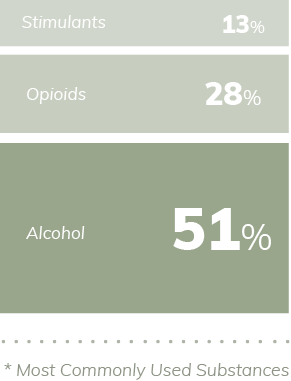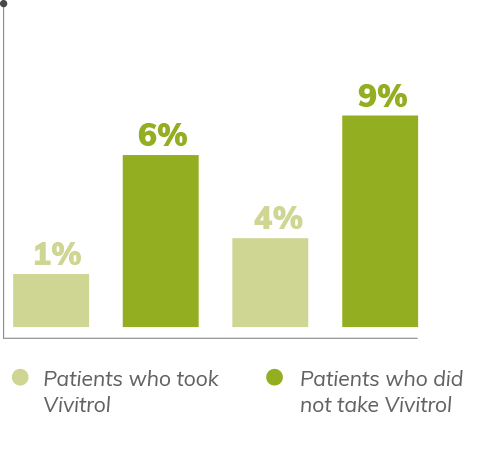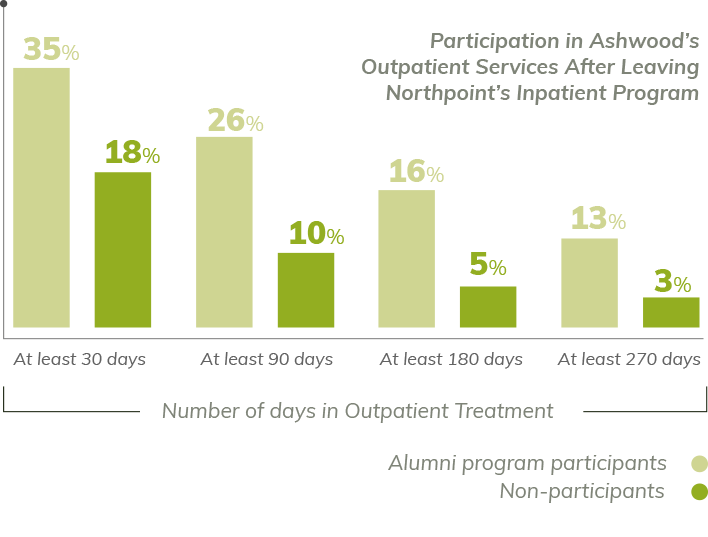Consider the Strength of Northpoint’s Inpatient Drug & Alcohol Rehab Program
Results from the Milliman Outcomes Assessment Report
What is the
Milliman Outcome
Assessment Report?
Northpoint prides itself on ethical, effective and caring practices in addiction recovery.
We wanted to provide an independent evaluation of our drug and alcohol addiction treatment program.
So we contracted Milliman - One of the world’s largest and most reputable companies that provide objective analytical and actuarial services.
We are one of the 1st addiction treatment centers to seek out, complete and share the results of an intensive Milliman study to assess our program and success rates.
About
The Report
The report analyses 3 key behaviors (outcomes) of a group of patients who received substance addiction treatment at Northpoint’s inpatient facility between May 2015 and August 2018. All patients were tracked for a year immediately after finishing their inpatient treatment.
Patients in the study received detox and/or rehabilitation services at Northpoint’s inpatient facility and used Northpoint’s services for outpatient/continued* treatment after discharge from May 2015 through August 2018.
*Outpatient services provided at the Ashwood Location
Northpoint Recovery’s 28-Day Inpatient Program
The detox and rehab program at Northpoint Recovery is an all-encompassing solution to drug and alcohol addiction treatment. Our inpatient program lasts 28 days with several weeks or months of outpatient care after discharge
Inpatient Treatment (Residential Care)
Offers full-time accommodation at our facility while patients undergo rigorous addiction treatment and therapy
Patients completing the inpatient program were less likely to be readmitted within a year of treatment
Patients receive round the clock professional medical support
Patients with longer stays at Northpoint were less likely to have non-compliant urinalysis results compared to patients with shorter stays
The 3 Patient
Outcomes Assessed
The key measurements used to assess the outcomes of treatment patients received at Northpoint were:
Readmission Rates
How many patients returned to Inpatient Care at Northpoint after being discharged (completing treatment or voluntarily leaving)
Engagement with Outpatient Therapy
How long patients used the services at our Outpatient Treatment Facility at Ashwood Recovery (continuing care) once they had left the Inpatient Care facility at Northpoint
Non-compliance with a Urinalysis
How many patients failed a drug test because one or more substances were found in their urine
Key Highlights From The Study
Patients who spent more time in the Inpatient Program at Northpoint had better results
Compared to other patients, those who stayed 22 days or more in the Inpatient Program:
Had lower readmission rates: Fewer had to go back to Inpatient treatment after leaving
Spent more time using our Outpatient Therapy services
Had higher rates of compliance with the urine drug test
Other Key
Highlights
Patients who received both detox and residential rehab treatment showed better outcomes than those only received one type of treatment
Those who received Vivitrol (Naltrexone) at the end of inpatient treatment showed better results than those who did not
Treatment was similarly effective for all patients, regardless of age, sex, or insurance coverage status
Drug Test (Urinalysis) Results
Patients were given urine drug tests in specific time periods:
0-30 Days | 31-90 Days | 91-180 Days | 181-270 Days | 271-365 Days
Among patients tested in the first 30 days after leaving inpatient care, 62% passed the drug test
However, of patients tested between 181 and 270 days after discharge, 75% of them passed the drug test
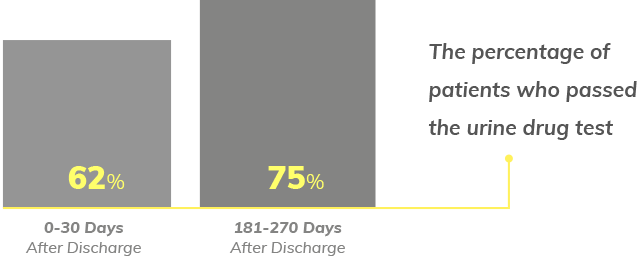
Readmission
Of all the patients in the study who were readmitted to the inpatient program at Northpoint:
5% were readmitted in the first 30 days
16% were readmitted within one year following discharge
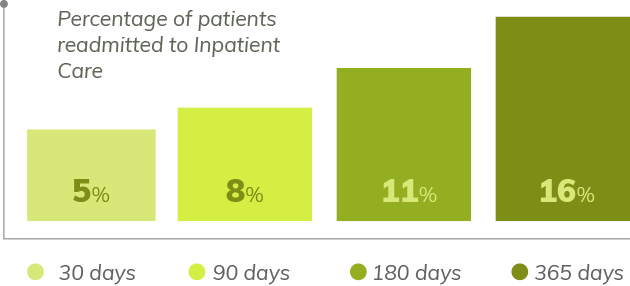
Length of Stay at Northpoint
The longer patients stayed in Northpoint’s Inpatient Program, the better their results
Longer Stays:
More than 28 days
Shorter Stays:
1-7 days
Compared to patients with shorter stays, longer stay patients were:
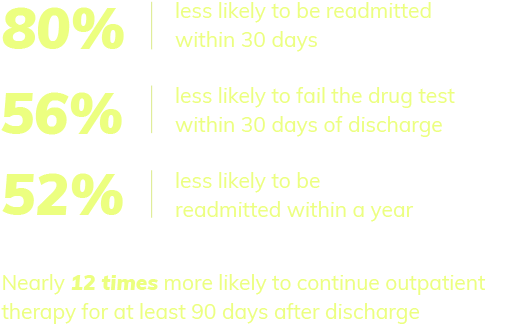
Patients who completed our recommended 28-Day Program, showed the best results
The first 30 days after discharge
Comparing the results of patients who stayed 7 days or less in inpatient care to those who stayed for 28 days or more
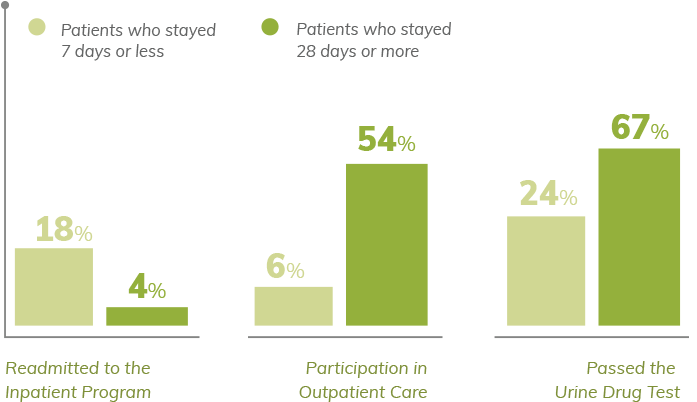
Patients who stayed for the full 28-day program showed significantly better results in the first 30 days after completing inpatient treatment
Vivitrol Success
Vivitrol helped patients to avoid relapse and readmission
Vivitrol is a injectable version
of the drug Naltrexone
As part of Northpoint’s treatment program, patients may be given Vivitrol to help prevent relapse
Naltrexone is used primarily to help prevent relapse to opioid dependence after detox and to treat alcohol dependence.
About 19% of patients were given Vivitrol at the end of inpatient treatment. Compared to patients who did not receive Vivitrol they:
Had lower 30-day, 60-day, and 180-day readmission rates
Were less likely to fail the urine drug test
Were more likely to use outpatient follow-up care
Alumni
Participation
Northpoint has an alumni Facebook group and app available for current and former patients
At Northpoint, we pride ourselves on having a strong alumni program where we continue to engage and connect alumni who have gone through any of our treatment programs
These supportive interactions include a private facebook page, in-person events, surveys, an e-newsletter and an app for phones. We believe, and our data supports, that those who participate in our alumni program are more likely to have long-term success


